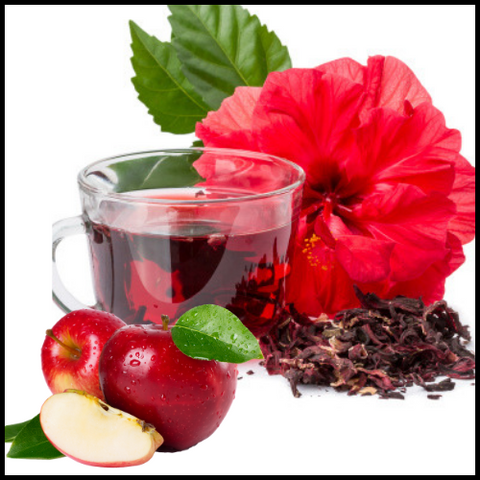Tisanes are infusions. The word Tisane comes from France and in ancient times, it originated as a medicinal drink that was chiefly barley water. Over time, it has evolved. Common herbal infusions are, of course, with Mint and other herbs such as Chamomile or Lemongrass. You may also have tried infusing Cinnamon, Ginger Root or Lemon Verbena. Tisanes are not Teas although the term ‘herbal tea’ is now synonymously used for herbal blends, fruit tisanes, rooibos and decaffeinated teas. An astute tea vendor will probe further when a customer walks in and asks for Herbal Tea.

Fruit Tisanes look and taste different from other herbal blends. Two key ingredients are often Hibiscus and Apple. Hibiscus provides the red color and tartness while apple pieces provide sweetness. Added to these two base ingredients may be fruit pieces such as berries, peach or mango bits, coconut, papaya or pineapple chunks, rosehips and flavorings such as vanilla. Beetroot is sometimes present to add more color to the blend. Tisanes are naturally caffeine-free and can be served hot or cold. They tend to have more body than commonly known herbal blends such as peppermint.
An important and useful attribute for this category – be it Tisanes or Herbal blends or Rooibos – is that all of it is naturally caffeine free. For those seeking a lower caffeine content, we recommend choosing an herbal blend or Fruit tisane rather than a decaffeinated tea. The difference between decaffeinated and non-caffeinated is that the first had caffeine which was then removed while the second category never had any to begin with. Some caffeine residue remains even with decaffeinated tea, so a non-caffeinated option is always the better way to go. Chamomile tea and Peppermint are probably the most popular of the herbs.
Fruit Tisanes are often divided into two groups – those with Hibiscus that steep a deep red and those without. The blends without Hibiscus have less tartness and the most popular blend in this category is our runaway bestseller – Toasted Almond.
Our Fruit Tisane selections have been selected and grouped by taste:
 |
SOUTH PACIFIC |
|
|
 |
 |
CHERRY JUBILEE |
|
MANGO FLIP |
 |
 |
 |
 |
|
PIÑA COLADA |
WOLFBERRY MELON |
TOASTED ALMOND |

Tisanes appeal to everyone – even real tea people! Although sometimes targeted towards only non-tea drinkers, Iced Tisanes are a particularly appealing summer refreshment. They make a great drink for children and a caffeine-free alternative to Iced Tea. Try these variations for an excellent, refreshing summer drink:
- Start with filling a glass with ice. Add half iced Tisane and top with Seltzer. Ideal choices are South Pacific and Cherry Jubilee.
- Blend Iced Tisane with Fruit Juice. Mango or Pineapple juice or puree complement Mango Flip and Piña Colada very well.
- Use Mango Flip, Hawaiian Berry or South Pacific to make a tangy Sangria with Red Wine.
- Blend it with Lemonade for a tangy, fruity drink. Fun for kids of all ages

Steeping Tisanes
Most of us are probably familiar with Black or Green tea. A few changes need to be made when steeping Fruit Tisanes because they consist of chunky fruit pieces and botanicals. There are no tea leaves in a fruit tisane so steeping a cup will need more time. Whereas a cup of black or green tea can be steeped perfectly in 3 or 4 minutes, a fruit tisane will need a good 5 -7 minutes depending on the ingredients. If a Tisane has hibiscus in it, it will color quicker. Without the presence of hibiscus, fruit pieces such as apple or mango will require a longer period to extract all the flavor into the cup. One other note to remember with Fruit Tisanes – don’t be tempted to add milk automatically. It may end up curdling the blend. Try tisanes iced – they are refreshing and pair well with fruit juice, lemonade or seltzer.


Iced Berry Sangria
You’ll need:
- 2 quarts Hawaiian Berry Fruit Tisane, steeped ( you may add some simple syrup if you want a sweeter flavored sangria).
- 1 (750ml) bottle of Red Moscato or any other sweet red wine you prefer.
- 2 cups berry juice
- ½ cup Brandy
- 2 lbs. assorted berries (sliced strawberries, blueberries, blackberries & raspberries)
Instructions:
- In a large pitcher, combine the fruit tisane, wine, juice and brand. Chill for at least 30 minutes, or overnight.
- Before serving, add the fruit to the pitcher or divide fruit among iced filled glasses. Pour the Sangria over the fruit & ice. Garnish with mint or rosemary sprigs if desired.
Makes: 12 Servings



